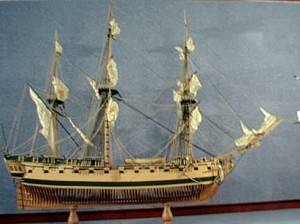Ship of the Line
Location: North Gallery
The Ship
HMS Alfred was named after King Alfred the Great, one of Britain’s most popular kings. He led the English forces who drove the Danes from Britain and is credited with being the father of the British Navy He supposedly invented the warship that later became the carrack. He also is credited with founding the University of Oxford.
Alfred first saw service in 1778. She was considered by Captain Kempenfelt (who drowned when Royal George capsized) to be a slow and cranky sailor. However, she served a long and useful career of 36 years with the Royal Navy—most of those years under Admiral Rodney. She sailed with Admiral Hood’s squadron in 1781 to take part in the action against Admiral De Grasse, which later became known as the “Battle of the Capes.” She had been appointed to lead the British van, but during maneuvers before the action started, found herself in the rear rather than the van and there is no indication that she ever fired a shot in this action.
In April 1782, she was back in the Caribbean with Admiral Rodney and was active in the “Battle of the Saintes” until she had expended all of her powder and shot. This is considered to be the final major naval engagement of the American Revolution and it broke the back of French naval power in the Caribbean.
Alfred returned to England and paid off in 1783, but this was not the end of her career. It appears that she was in Admiral Hood’s division under Admiral Howe during “The Glorious First of June” victory over the French.
She was back in the Caribbean in the 1790s seeing active service, and it is suggested that she was in a fleet under Gambier during the Battle of Copenhagen in 1807. Alfred was broken up in 1814 after a long and active career.
The Model
H 38.2” L 48.4” W 21.1”
Plank on exposed frame. This model is beautifully built by M. W. Brown circa 1997.
Note: The 74-gun ship of the line was the work-horse of the British and French fleets during the late 18th Century. They were not as dashing as the frigates or as powerful as the 100-gun first-raters. But they were powerful enough to drive away frigate raiders and didn’t require the huge ships and crews of the “Wooden Walls of England.” In other words, they occupied the same niche in the 18th Century navies that the heavy cruisers did in World War II.
